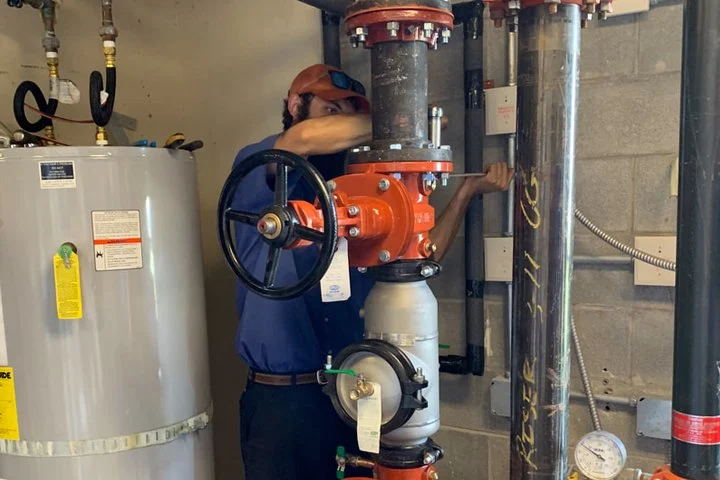Backflow in plumbing systems can lead to serious health risks and contamination of potable water supplies. To prevent such issues, a key device known as a backflow preventer is used. This article delves into the significance of backflow prevention, explores the different types of backflow preventers, and highlights their importance in maintaining safe and clean water systems.
What is Backflow?

Defining Backflow
Backflow is the undesirable reversal of the flow of water in a plumbing system. It occurs when the pressure in the water supply system drops, causing water to flow backward from private properties into the public water supply. This reversal can introduce contaminants, such as chemicals, bacteria, and other harmful substances, into the clean water supply.
Causes of Backflow
- Backpressure: This happens when the pressure in the downstream piping system becomes higher than the supply pressure. Common causes include pumps, elevated tanks, and boiler systems.
- Backsiphonage: This occurs due to a sudden reduction in supply pressure, often caused by a main water line break, firefighting, or heavy water demand. This can create a vacuum that pulls contaminated water back into the system.
The Importance of Preventing Backflow
Health and Safety
Preventing backflow is crucial to ensuring the safety of drinking water. Contaminated water can lead to severe health issues, including gastrointestinal illnesses, respiratory problems, and other diseases. Ensuring that backflow does not occur is a key responsibility of public health and safety regulations.
Regulatory Compliance
Many regions have strict regulations and codes to ensure that plumbing systems are equipped with backflow preventers. Compliance with these regulations is mandatory for both residential and commercial properties to safeguard public health and avoid legal penalties.
Types of Backflow Preventers
There are several types of backflow preventers, each designed to handle specific backflow scenarios. Understanding the different types can help in selecting the appropriate device for various plumbing systems.
Air Gap
An air gap is the simplest and most effective method of preventing backflow. It involves a physical separation between the water supply outlet and the flood level of the fixture. This gap ensures that contaminated water cannot siphon back into the clean water supply.
- Advantages: Simple, reliable, no moving parts.
- Disadvantages: Requires space, not suitable for all installations.
Double Check Valve Assembly (DCVA)
A DCVA consists of two check valves assembled in series, with test cocks and shut-off valves. It is designed to prevent backflow in low to medium hazard situations.
- Advantages: Compact, suitable for a wide range of applications.
- Disadvantages: Requires periodic testing and maintenance.
Reduced Pressure Zone (RPZ) Assembly
An RPZ assembly includes two check valves with a pressure relief valve in between. It is designed to provide protection in high hazard situations where the contaminants could cause serious health risks.
- Advantages: High level of protection, reliable.
- Disadvantages: More complex, requires regular testing and maintenance.
Pressure Vacuum Breaker (PVB)
A PVB is designed to prevent backflow due to backsiphonage. It consists of a check valve and an air inlet valve that opens to break the vacuum if backsiphonage occurs.
- Advantages: Suitable for irrigation systems, easy to install.
- Disadvantages: Not effective against backpressure, requires annual testing.
Atmospheric Vacuum Breaker (AVB)
An AVB is a simple device installed on the discharge side of the last control valve. It uses a check valve and an air inlet that opens when negative pressure is detected.
- Advantages: Inexpensive, easy to install.
- Disadvantages: Must be installed downstream of all shut-off valves, not effective against backpressure.
How to Choose the Right Backflow Preventer
Selecting the appropriate backflow preventer depends on several factors, including the level of hazard, the type of system, and local regulations. Here are some steps to help choose the right device:
Assess the Hazard Level
Determine whether the situation involves low, medium, or high hazard potential. For instance, residential systems typically require lower hazard prevention compared to industrial systems.
Understand Local Codes and Regulations
Consult local plumbing codes and regulations to ensure compliance. Different regions may have specific requirements for backflow prevention devices.
Consider the System Type
Evaluate the type of plumbing system and the specific backflow risks associated with it. For example, irrigation systems might benefit from PVBs, while industrial systems might need RPZ assemblies.
Maintenance and Testing Requirements
Consider the maintenance and testing requirements for each type of backflow preventer. Some devices require more frequent inspections and maintenance, which can impact long-term costs and reliability.
Installation and Maintenance of Backflow Preventers
Professional Installation
It is crucial to have backflow preventers installed by qualified professionals. Proper installation ensures that the device functions correctly and complies with local regulations.
Regular Testing and Maintenance
Backflow preventers require regular testing and maintenance to ensure they are functioning correctly. Many regions mandate annual testing by certified professionals. Regular maintenance includes checking for leaks, ensuring valves operate smoothly, and replacing worn-out components.




